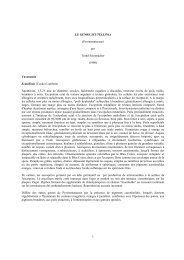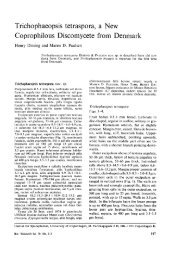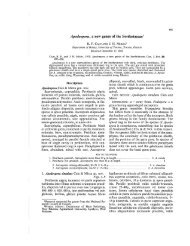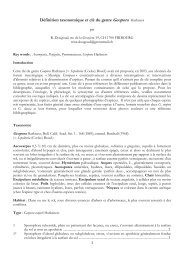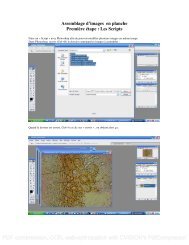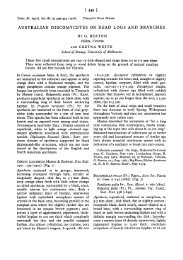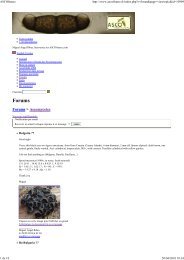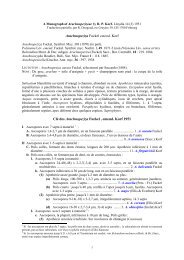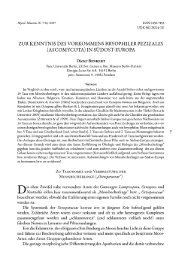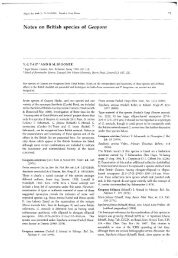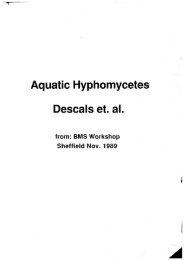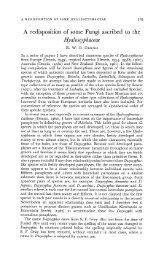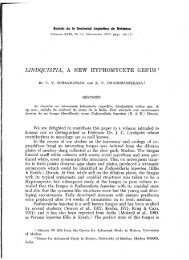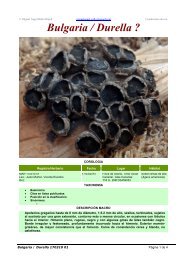Stray Studies in the Coronophorales (Pyrenomycetes) 4-8 - ASCOfrance
Stray Studies in the Coronophorales (Pyrenomycetes) 4-8 - ASCOfrance
Stray Studies in the Coronophorales (Pyrenomycetes) 4-8 - ASCOfrance
You also want an ePaper? Increase the reach of your titles
YUMPU automatically turns print PDFs into web optimized ePapers that Google loves.
310 J. A. NannfeldtAscocarps deeply cupulate, 0.25-0.4 mm, densely gregarious, surrounded by ara<strong>the</strong>r sparse, dist<strong>in</strong>ctly brown (not blackish) subiculum. Asci ca. 32-sporous.Spores suballantoid, slightly curved, 7-9x1.5 /im, hyal<strong>in</strong>e with one drop <strong>in</strong> eachend.DISTRIBUTION: Seems conf<strong>in</strong>ed to North America; seen by me only from <strong>the</strong>East: Canada (Ontario) and USA (Alabama, Connecticut, Maryland, Pennsylvania,South Carol<strong>in</strong>a, Virg<strong>in</strong>ia) but recorded also from <strong>the</strong> West (USA: Oregon, Zeller1927:130). — A record from Sweden is erroneous (see Chapt. 8). Judged from <strong>the</strong>description and illustration, a record (Teng 1936:506) from Ch<strong>in</strong>a (Hunan) is notconv<strong>in</strong>c<strong>in</strong>g. It may be an undescribed Species.(6) Nitschkia calyculus (Mont.) O. Kze, Rev. gen. pi. 3(2): 501 (1898; "Nitschkea")-,Berl., Icon. fung. 3:22 (1900).Sphaeria (Caespitosa) calyculus Mont., Ann. Sei. Nat. Bot. 2(14): 322 (1840); Syll. crypt, p.226 (1856). —Byssosphaeria (Caelosphaeria) calyculus Cke, Grevillea 15(=n. 76): 122 (1887).— Coelosphaeria (?) calyculus Sacc., Syll. fung. 9:444 (1891). — W<strong>in</strong>ter<strong>in</strong>a calyculus Höhn.Ann. Mycol. 16(1-2): 105 (1918). — Calyculosphaeria calyculus fitzp., Mycologia 15(2):51(1923). — Typus: French Guiana, Leprieur 372 (PC!).Similar to N. grevillii. Ascocarps 0.35-0.5 mm. Asci 8-sporous. Spores ellipsoid tosubcyl<strong>in</strong>drical, almost straight, only 5-7x1.5-2 ¡im, <strong>the</strong> smallest amongst <strong>the</strong>8-sporous species, hyal<strong>in</strong>e, with one droplet <strong>in</strong> each end.DISTRIBUTION: North America (USA: Florida, Petrak 1952c:400, as Cal.trist.; W!), Tropical South America (French Guiana) and Tropical Africa (Ghana,IMI!; Hughes 1953:11 as Cal.trist.).(7) Nitschkia chaetomioides (Penz. & Sacc.) Nannf. nov. comb.Enchnoa chaetomioides Penz. & Sacc., Malpighia 11(4): 390 (1897); Icon. fung. javan. p. 4(1904). —Coronophorella chaetomioides Höhn., Sitz. ber. Akad. Wiss. Wien, Math.-nat. Kl.118(1): 1507 (1909). — Scortech<strong>in</strong>ia chaetomioides Arx & Müll., Beitr. Krypt.-fl. Schweiz11(1):381 (1954). — Tympanopsis chaetomioides Arx & Müll., Phytopath. Zeitschr. 24(4):365(1955). — Typus: Java, Penzig 260bis (holotypus: PAD!; isotypus: W!).Similar to N. acanthostromabut <strong>the</strong> dichotomously branched end<strong>in</strong>gs of <strong>the</strong>subicular hyphae not sp<strong>in</strong>y. Ascocarps 0.3-0.4 mm. Asci 8-sporous. Spores suballantoidto subreniform, 6-8x2-3 /im, hyal<strong>in</strong>e, with one large drop <strong>in</strong> each end.DISTRIBUTION: Accord<strong>in</strong>g to Arx & Müller (1954:381) "Indischer Archipel,Afrika, Südamerika", often mistaken forN. acanthostromaand probably not rare <strong>in</strong><strong>the</strong> Tropics. Seen by me only from Africa (Ghana, Sierra Leone, IMI!) and Asia(Java).(8) Nitschkia collapsa (Rom.) Chen., Bull. Soc. Mycol. Fr. 34(1-2):73 (1918;"Nitschkea").SvenskBot. Tidskr. 69 (1975)



